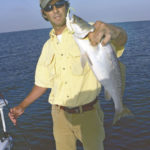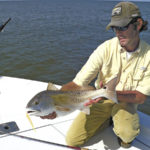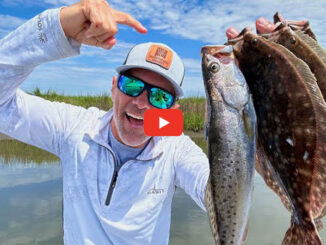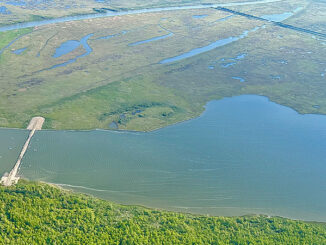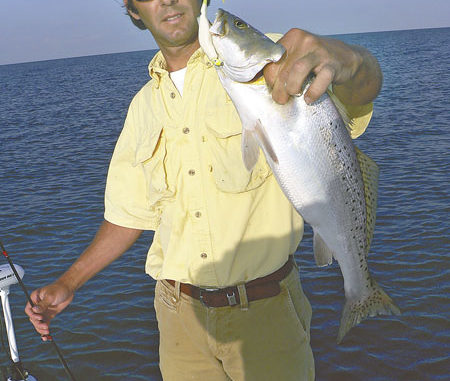
This Lake Pelto hotspot is on fire this year. Fish it, and you won’t be able to get it out of your head.
We all know what it is to crave something. Hot boiled crawfish, ice cold watermelon, that first cup of coffee in the morning — we all have these appetites that arise and then long to be satisfied.
My wife had strange cravings when she was expecting our first child. She wanted Chinese food, had to have it, at four in the morning! Try finding a Chinese restaurant open at 4 a.m.!
Some cravings strike suddenly like that and demand fulfillment. Other cravings just seem to park in your mind and nag you until you act on them. Sometimes I’ll crave a cheeseburger. Not just any cheeseburger, but a Bud’s Broiler cheeseburger. Or I’ll crave Mexican food, or Middendorf’s thin fried catfish or a Hubig’s fried pie.
You know how it is. And once the itch strikes, you just gotta scratch it.
I’ve had an itch to fish Cocodrie for more than 20 years. It’s been one of those nagging cravings that I’ve never been able to satisfy. I’ve often wondered how come I never made a fishing trip out of Cocodrie. I didn’t intentionally avoid it; in fact, I actually planned some trips there down through the years, but something always came up and cancelled them.
But I was determined not to let that happen this time. This time would be different.
I talked to Capt. Ryan Young of Avid Angler Fishing Charters (985-855-5909), a young guide who grew up plying the waters around Houma and fishes out of Dularge and Cocodrie, and asked him to call me when the big trout started showing up. And he did. He said he’d slammed some big specks on topwater baits that very morning, and lost what was probably the biggest trout of his life right alongside the boat, a fish he estimated to go 8 pounds!
“I’m going back to that spot tomorrow morning to catch that big trout, and I called to see if you want to come along,” he said.
Did I want to come along?
“I’ll be there,” I replied.
In fact, I answered him before he even finished asking. I had an itch to scratch, and the lure of an 8-pound trout was more than I could resist.
We met at Coco Marina before daylight, and loaded my gear into Young’s 23-foot Ranger, and the 225 Yamaha soon had us zipping toward our destination — the Lake Pelto Sulfur Mine.
Freeport Sulfur developed the site of this mine back in 1955. The sulfur was buried under 6 feet of open water, so they constructed a man-made island for their mining operations and spent a considerable sum in the process.
The mine is about two miles north of East Island in the Isles Dernieres chain of barrier islands. The whole chain is a state refuge and a haven for sea birds of all kinds, and a perennial hotspot for trout and redfish anglers.
The Freeport mine operated from 1960 until 1975, and produced more than 5 1/2 million tons of sulfur in the process. Today, only a skeleton remains of the old operation. The rest disappeared due to storms and the well-known ravages of salt water over time. But the island remains, though badly eroded, and is well known for holding trout and redfish, especially this time of year.
As Young wound his way through the marsh, I had visions of mega-sized trout, those 7- and 8-pound wall-hangers that take your breath away and make grown
men squeal like girls. I envisioned the kind of trout that win the STAR tournament and reward you with a brand-new boat, motor and trailer. And Young fueled my expectations by regaling me again with the story of the one
that got away, breaking off right alongside his boat the day before.
But I got deflated as soon as we hit the open water. The seas were rough, much rougher than the forecast, and every trout angler knows what that means. Heavy wave action stirs up the bottom and makes the water murky, especially in the shallow waters we were planning to fish. Trout don’t like muddy water. Plus, the direction of the wind would have the rough seas crashing ashore and making the conditions worst in the area we wanted to fish. It wasn’t looking too good.
But Young was undeterred. He headed straight to the point where he’d hooked the big fish the day before, only to have his expectations dashed also. A boat was parked over the exact spot. It was bouncing up and down in the waves like a kid with an urgent need to use the restroom, but there it sat, anchored, in our spot.
Young gave the spot-stealing boat wide berth, and maneuvered to the lee side of the island where we’d be out of the rough seas and could search for decent water. We didn’t have to go far before the water cleaned up, and we had some very decent, fishable conditions.
Young manned the trolling motor and started out casting a MirrOlure Top Dog in mullet color. I had the rest of the boat to myself, and tossed a She Dog in bone/chrome.
The backside of the island has a lot of structure that attracts fish. Rows of pilings jut out into the water, and the shoreline is covered in old slabs of broken concrete. All are perfect places to snag your line, or snag a big redfish or trout lurking in ambush along the structure.
Young was the first to hook a trout, a 2-plus-pounder that couldn’t resist the topwater lure. It wasn’t an 8-pounder, but it was a good fish, and under these conditions I was glad to see anything bite.
Young had a few more hits on the topwater bait, but most of them were short-strikes. To me, topwater fishing is the ultimate thrill. That sudden slam and run still gives me an adrenaline rush, but it can also be frustrating when they ignore your bait and hit everybody else’s, or they continually pop at it without getting hooked, or they simply turn their nose up at it altogether. And that’s what they did to my bait.
Young caught a few more similar-sized trout on the topwater before the bite quit, while I didn’t get a single hit. I didn’t even have the thrill of a short-strike.
Once it became evident that the trout were no longer enticed by the topwater baits, we switched tactics. Young began tossing a Norton Sand Eel in glow/chartreuse in between the rows of pilings that jut a short distance out into the water. He had it threaded on a ¼-ounce chartreuse jig head, and on his second cast he got a good strike. I netted the 2 1/2-pound trout, and he tossed his bait right back to the same spot and caught another one.
“I use these Norton Sand Eels a lot down here, and have been very successful with them,” Young explained. “They seem to have a good bit of movement in the water and the trout just suck them in.”
I was tightlining a tried-and-true opening night-colored lure on a plain round jig head, but without much success. I’m normally very confident tossing this particular bait, but as I watched Young catch trout after trout, having to reel in my unproductive bait to net each fish, my confidence in it waned. I switched to a Sand Eel in a gold color, the only color of that lure I had on hand, and got the same results as before.
“You need to switch to this glow/chartreuse color bait, and this chartreuse jig head,” Young said, seeing my frustration.
So I did. And on my first cast I hung up on a piling and had to break off the line.
We continued to work along the shoreline on the lee side of the island, tossing our baits in between the rows of pilings and up near the broken slabs of concrete along the bank, pulling out trout after trout. I was now successfully tossing a curl-tail Salt Water Assassin in solid white, and discovered that I really had to keep my line tight and start reeling as soon as I got a strike because if I allowed any play in the line the fish would run up into the tangle of pilings and break off my line.
The action wasn’t fast and furious, but it was steady, and while the fish weren’t the monsters we’d hoped for, they were more than respectable and willing to put up a good fight. Considering the conditions, we were having a great day.
I noticed that as we fished, every now and then Young would stretch to see if that spot-stealing boat was still anchored in his 8-pound trout hole. For most of the morning, the boat stayed right there, bobbing in the seas, and as far as we could tell, catching nothing.
Finally the boat gave up and moved, and Young began trolling us into the bouncing waves toward his honey hole. Once we left the calm lee side of the island, the water became increasingly cloudy and then downright muddy. It was obvious we were on a fruitless quest, but it was one I knew he had to make. He had to at least make a few casts in that spot before leaving just to be sure that the 8-pound beast wasn’t there.
We bounced up and down on the rough side for the better part of an hour, hoping against hope that that whale of a trout would somehow stumble blindly into our bait and get himself hooked. But it just wasn’t to be.
Reluctantly, Young gave up on the Sulfur Mine and pointed the bow of the Ranger toward a nearby island where we’d work our way along the lee shoreline, casting
and retrieving.
“Somebody is going to catch an 8-pound trout right here in May or June,” he said, pointing to the debris-ridden Sulfur Mine island. “I’m certain of it. There are some really big fish in here right now, and somebody is going to catch them.”
Back at the Coco Marina dock, Mike Glover said the trout action will be excellent all along the beaches and on both sides of the islands. Nearby structures, such as wells and rigs, will also attract trout and reds, and the rocks along the islands are favorite haunts of both reds and specks. Live baits Carolina-rigged, topwater baits (fished early or late) and soft plastics tightlined or under corks will put some stretch in your line and a bend in your rod, he said.
I’m starting to itch again, and it ain’t fleas or a rash. It’s a Cocodrie craving, and the faint call of an 8-pound trout with my name on it.
Capt. Ryan Young can be reached at (985) 855-5909.
